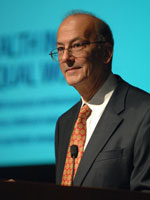Answering the call to action with science
July / August 2012 | Volume 11, Issue 4

Dr. Roger I. Glass,
Director of the Fogarty
International Center
Opinion by Dr. Roger I. Glass
Director, Fogarty International Center
Twenty-five years ago, we were horrified to see the toll HIV/AIDS was taking in the developing world. Not only did it wipe out nearly a generation of adults in sub-Saharan Africa, it also killed countless children and left many more orphans. After several decades of improving indicators of health, life expectancy in sub-Saharan Africa began a sharp decline linked directly to the consequences of HIV on the entire population.
Today, the situation has changed dramatically - we are now able to manage the disease through drugs and we've learned how to prevent HIV-positive mothers from passing the virus to their babies. We've also discovered ways to reduce transmission through male circumcision, discordant couple's counseling and treatment as prevention. All of these advances required the efforts of talented, well-trained researchers.
At Fogarty, we're proud of the role we've played in developing scientific expertise in the parts of the world most affected by the HIV epidemic. Through our AIDS International Research and Training Program (AITRP), we've helped produce a cadre of well-qualified HIV/AIDS researchers and clinicians in 100 developing countries. They have become equal research partners, working in collaboration with American scientists and others around the globe, studying the most promising interventions and how best to implement them effectively in low-resource settings. In fact, many of the major advances in HIV research in these settings have been the product of research conducted by Fogarty trainees.
And yet, we must do more. As the world's HIV/AIDS scientists, advocates, policymakers and others gather in Washington for the AIDS 2012 meeting, we must consider what we can do to speed progress. U.S. Secretary of State Hillary Rodham Clinton has set an ambitious goal for us - creating an AIDS-free generation. By continuing to push for new ways to prevent and treat the disease - and by more efficiently incorporating these discoveries into practice, we can achieve this lofty goal.
At the NIH, we are also committed to Secretary Clinton's Call to Action to eliminate preventable child deaths. (See the related article, A call to action: Ending preventable child death in a generation from the May / June 2012 issue of Global Health Matters.) Although perhaps an aspirational goal for some countries, we can certainly accelerate progress everywhere by more closely linking research discoveries with development practice and by reinforcing the research agenda to improve compliance, lower costs and better understand the medical issues among people now living long-term with HIV.
But for children under 5, pneumonia, diarrhea, malaria and neonatal conditions claim the most lives. By prioritizing research in these areas, we can identify and implement new lifesaving, cost-effective measures that will help bend the curve and drive down the number of child deaths.
As Secretary Clinton pointed out, this isn't only about building a more just and equitable world. By preventing child deaths, delaying and better spacing pregnancies and decreasing family size, countries eventually have a more productive work force with more adults supporting fewer dependents. This demographic “dividend” can encourage economic growth, make countries more stable, less prone to political crises and more apt to become partners to help solve global problems. So for all these reasons - politically, economically and morally - there are clear benefits to saving children's lives.
Fogarty has been a leader in training for research in global health. Our programs to support HIV have been the longest standing and have helped build the workforce for research and training throughout the developing world. We are committed to studying the research gaps that remain, to provide a credible evidence base that will drive decision making and increase efficiencies so we can achieve our goal of ending preventable child deaths everywhere.
At the NIH, we are excited to partner with the USAID in a new research funding program that will move us forward. The PEER Health awards provide a tremendous opportunity for collaborations that address research-to-practice barriers, while building scientific capacity and more closely linking USAID missions with health and research institutions in developing countries.
In addition, we are beginning to see the benefits of our collaboration to transform medical education in sub-Saharan Africa. With support from the President's Emergency Plan for AIDS Relief and our NIH partners, we are enhancing health science curricula and making quality online training more widely available to address the tremendous shortfall of health care workers and scientists across the region.
We must be ambitious and relentless to do our part in building the research workforce needed to achieve our goal. The world's most vulnerable citizens are depending on us.
More Information
To view Adobe PDF files,
download current, free accessible plug-ins from Adobe's website.